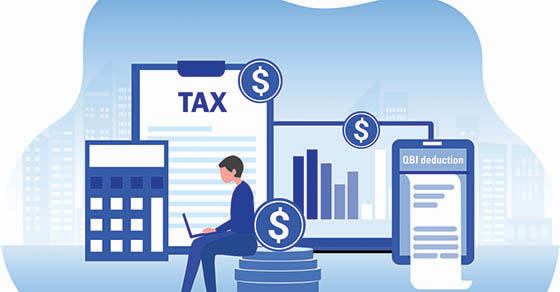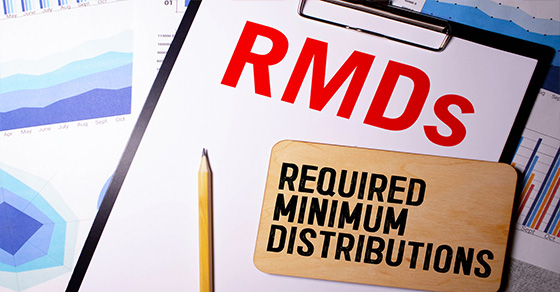Weekly Tax Brief
Save for retirement by getting the most out of your 401(k) plan
- Details
- Published: 23 December 2022 23 December 2022

Socking away money in a tax-advantaged retirement plan can help you reduce taxes and help secure a comfortable retirement. If your employer offers a 401(k) or Roth 401(k), contributing to the plan is a smart way to build a substantial nest egg.
If you’re not already contributing the maximum allowed, consider increasing your contribution. Because of tax-deferred compounding (tax-free in the case of Roth accounts), boosting contributions can have a major impact on the amount of money you’ll have in retirement.
With a 401(k), an employee makes an election to have a certain amount of pay deferred and contributed by an employer on his or her behalf to the plan. The amounts are indexed for inflation each year and not surprisingly, they’re going up quite a bit. The contribution limit in 2023 is $22,500 (up from $20,500 in 2022). Employees age 50 or older by year end are also permitted to make additional “catch-up” contributions of $7,500 in 2023 (up from $6,500 in 2022). This means those 50 and older can save a total of $30,000 in 2023 (up from $27,000 in 2022).
Contributing to a traditional 401(k)
A traditional 401(k) offers many benefits, including:
- Contributions are pretax, reducing your modified adjusted gross income (MAGI), which can also help you reduce or avoid exposure to the 3.8% net investment income tax.
- Plan assets can grow tax-deferred — meaning you pay no income tax until you take distributions.
- Your employer may match some or all of your contributions pretax.
If you already have a 401(k) plan, take a look at your contributions. In 2023, you may want to try and increase your contribution rate to get as close to the $22,500 limit (with an extra $7,500 if you’re age 50 or older) as you can afford. Keep in mind that your paycheck will be reduced by the amount of the contribution only, because the contributions are pretax — so, income tax isn’t withheld.
Contributing to a Roth 401(k)
Employers may also include a Roth option in their 401(k) plans. If your employer offers this, you can designate some or all of your contributions as Roth contributions. While such amounts don’t reduce your current MAGI, qualified distributions will be tax-free.
Roth 401(k) contributions may be especially beneficial for higher-income earners, because they don’t have the option to contribute to a Roth IRA. That’s because your ability to make a Roth IRA contribution is reduced or eliminated if your adjusted gross income exceeds certain amounts.
Looking ahead
Contact us if you have questions about how much to contribute or the best mix between traditional and Roth 401(k) contributions. We can also discuss other tax and retirement-saving strategies in your situation.
© 2022
How to minimize the S corporation LIFO recapture tax
- Details
- Published: 23 December 2022 23 December 2022

If you’re considering converting your C corporation to an S corporation, be aware that there may be tax implications if you’ve been using the last in, first out (LIFO) inventory method. That’s because of the LIFO recapture income that will be triggered by converting to S corporation status. We can meet to compute what the tax on this recapture would be and to see what planning steps might be taken to minimize it.
Inventory reporting
As you’re aware, your corporation has been reporting a lower amount of taxable income under LIFO than it would have under the first in, first out (FIFO) method. The reason: The inventory taken into account in calculating the cost of goods sold under LIFO reflects current costs, which are usually higher.
This benefit of LIFO over FIFO is equal to the difference between the LIFO value of inventory and the higher value it would have had if the FIFO method had been used. In effect, the tax law treats this difference as though it were profit earned while the corporation was a C corporation. To make sure there’s a corporate-level tax on this amount, it must be “recaptured” into income when the corporation converts from a C corporation to an S corporation. Also, the recapture amount will increase the corporation’s earnings and profits, which can have adverse tax consequences down the road.
Soften the blow
There are a couple of rules that soften the blow of this recapture tax to some degree.
- The increase in tax imposed on the C corporation in its final tax year because of the LIFO recapture may be paid over a four-year period.
- The basis of the corporation’s inventory will be increased by the amount of income recognized. So, the net effect may be one primarily of timing — because of the basis increase, the corporation may realize less income in later years, though only if there are decrements in the adjusted LIFO layer.
We can help you gauge your exposure to the LIFO recapture tax and can suggest strategies for reducing it. Contact us to discuss these issues in detail.
© 2022
Selling stock by year-end? Watch out for the wash sale rule
- Details
- Published: 15 December 2022 15 December 2022

If you’re thinking about selling stock shares at a loss to offset gains that you’ve realized during 2022, it’s important to watch out for the “wash sale” rule.
The loss could be disallowed
Under this rule, if you sell stock or securities for a loss and buy substantially identical stock or securities back within the 30-day period before or after the sale date, the loss can’t be claimed for tax purposes. The rule is designed to prevent taxpayers from using the tax benefit of a loss without parting with ownership in any significant way. Note that the rule applies to a 30-day period before or after the sale date to prevent “buying the stock back” before it’s even sold. (If you participate in any dividend reinvestment plans, it’s possible the wash sale rule may be inadvertently triggered when dividends are reinvested under the plan, if you’ve separately sold some of the same stock at a loss within the 30-day period.)
The wash sale rule even applies if you repurchase the security in a tax-advantaged retirement account, such as a traditional or Roth IRA.
Although a loss can’t be claimed on a wash sale, the disallowed amount is added to the cost of the new stock. So, the disallowed amount can be claimed when the new stock is finally disposed of in the future (other than in a wash sale).
Let’s look at an example
Say you bought 500 shares of ABC, Inc. for $10,000 and sold them on November 4 for $3,000. On November 29, you buy 500 shares of ABC again for $3,200. Since the shares were “bought back” within 30 days of the sale, the wash sale rule applies. Therefore, you can’t claim a $7,000 loss. Your basis in the new 500 shares is $10,200: the actual cost plus the $7,000 disallowed loss.
If only a portion of the stock sold is bought back, only that portion of the loss is disallowed. So, in the above example, if you’d only bought back 300 of the 500 shares (60%), you’d be able to claim 40% of the loss on the sale ($2,800). The remaining $4,200 loss that’s disallowed under the wash sale rule would be added to your cost of the 300 shares.
If you’ve cashed in some big gains in 2022, you may be looking for unrealized losses in your portfolio so you can sell those investments before year-end. By doing so, you can offset your gains with your losses and reduce your 2022 tax liability. But be careful of the wash sale rule. We can answer any questions you may have.
© 2022
Do you qualify for the QBI deduction? And can you do anything by year-end to help qualify?
- Details
- Published: 13 December 2022 13 December 2022

If you own a business, you may wonder if you’re eligible to take the qualified business income (QBI) deduction. Sometimes this is referred to as the pass-through deduction or the Section 199A deduction.
The QBI deduction is:
- Available to owners of sole proprietorships, single member limited liability companies (LLCs), partnerships, and S corporations, as well as trusts and estates.
- Intended to reduce the tax rate on QBI to a rate that’s closer to the corporate tax rate.
- Taken “below the line.” In other words, it reduces your taxable income but not your adjusted gross income.
- Available regardless of whether you itemize deductions or take the standard deduction.
Taxpayers other than corporations may be entitled to a deduction of up to 20% of their QBI. For 2022, if taxable income exceeds $170,050 for single taxpayers, or $340,100 for a married couple filing jointly, the QBI deduction may be limited based on different scenarios. For 2023, these amounts are $182,100 and $364,200, respectively.
The situations in which the QBI deduction may be limited include whether the taxpayer is engaged in a service-type of trade or business (such as law, accounting, health or consulting), the amount of W-2 wages paid by the trade or business, and/or the unadjusted basis of qualified property (such as machinery and equipment) held by the trade or business. The limitations are phased in.
Year-end planning tip
Some taxpayers may be able to achieve significant savings with respect to this deduction (or be subject to a smaller phaseout of the deduction), by deferring income or accelerating deductions at year-end so that they come under the dollar thresholds for 2022. Depending on your business model, you also may be able to increase the deduction by increasing W-2 wages before year-end. The rules are quite complex, so contact us with questions and consult with us before taking the next steps.
© 2022
Answers to your questions about taking withdrawals from IRAs
- Details
- Published: 08 December 2022 08 December 2022

As you may know, you can’t keep funds in your traditional IRA indefinitely. You have to start taking withdrawals from a traditional IRA (including a SIMPLE IRA or SEP IRA) when you reach age 72.
The rules for taking required minimum distributions (RMDs) are complicated, so here are some answers to frequently asked questions.
What if I want to take out money before retirement?
If you want to take money out of a traditional IRA before age 59½, distributions are taxable and you may be subject to a 10% penalty tax. However, there are several ways that the 10% penalty tax (but not the regular income tax) can be avoided, including to pay: qualified higher education expenses, up to $10,000 of expenses if you’re a first-time homebuyer and health insurance premiums while unemployed.
When do I take my first RMD?
For an IRA, you must take your first RMD by April 1 of the year following the year in which you turn 72, regardless of whether you’re still employed.
How do I calculate my RMD?
The RMD for any year is the account balance as of the end of the immediately preceding calendar year divided by a distribution period from the IRS’s “Uniform Lifetime Table.” A separate table is used if the sole beneficiary is the owner’s spouse who is 10 or more years younger than the owner.
How should I take my RMDs if I have multiple accounts?
If you have more than one IRA, you must calculate the RMD for each IRA separately each year. However, you may aggregate your RMD amounts for all of your IRAs and withdraw the total from one IRA or a portion from each of your IRAs. You don’t have to take a separate RMD from each IRA.
Can I withdraw more than the RMD?
Yes, you can always withdraw more than the RMD. But you can’t apply excess withdrawals toward future years’ RMDs.
In planning for RMDs, you should weigh your income needs against the ability to keep the tax shelter of the IRA going for as long as possible.
Can I take more than one withdrawal in a year to meet my RMD?
You may withdraw your annual RMD in any number of distributions throughout the year, as long as you withdraw the total annual minimum amount by December 31 (or April 1 if it is for your first RMD).
What happens if I don’t take an RMD?
If the distributions to you in any year are less than the RMD for that year, you’ll be subject to an additional tax equal to 50% of the amount that should have been paid out, but wasn’t.
Plan ahead wisely
Contact us to review your traditional IRAs and to analyze other aspects of your retirement planning. We can also discuss who you should name as beneficiaries and whether you could benefit from a Roth IRA. Roth IRAs are retirement savings vehicles that operate under a different set of rules than traditional IRAs. Contributions aren’t deductible but qualified distributions are generally tax-free.
© 2022
Choosing a business entity? Here are the pros and cons of a C corporation
- Details
- Published: 07 December 2022 07 December 2022

If you’re launching a new business venture, you’re probably wondering which form of business is most suitable. Here is a summary of the major advantages and disadvantages of doing business as a C corporation.
A C corporation allows the business to be treated and taxed as a separate entity from you as the principal owner. A properly structured corporation can protect you from the debts of the business yet enable you to control both day-to-day operations and corporate acts such as redemptions, acquisitions and even liquidations. In addition, the corporate tax rate is currently 21%, which is lower than the highest noncorporate tax rate.
Following formalities
In order to ensure that a corporation is treated as a separate entity, it’s important to observe various formalities required by your state. These include:
- Filing articles of incorporation,
- Adopting bylaws,
- Electing a board of directors,
- Holding organizational meetings, and
- Keeping minutes of meetings.
Complying with these requirements and maintaining an adequate capital structure will ensure that you don’t inadvertently risk personal liability for the debts of the business.
Potential disadvantages
Since the corporation is taxed as a separate entity, all items of income, credit, loss and deduction are computed at the entity level in arriving at corporate taxable income or loss. One potential disadvantage to a C corporation for a new business is that losses are trapped at the entity level and thus generally cannot be deducted by the owners. However, if you expect to generate profits in year one, this might not be a problem.
Another potential drawback to a C corporation is that its earnings can be subject to double tax — once at the corporate level and again when distributed to you. However, since most of the corporate earnings will be attributable to your efforts as an employee, the risk of double taxation is minimal since the corporation can deduct all reasonable salary that it pays to you.
Providing benefits, raising capital
A C corporation can also be used to provide fringe benefits and fund qualified pension plans on a tax-favored basis. Subject to certain limits, the corporation can deduct the cost of a variety of benefits such as health insurance and group life insurance without adverse tax consequences to you. Similarly, contributions to qualified pension plans are usually deductible but aren’t currently taxable to you.
A C corporation also gives you considerable flexibility in raising capital from outside investors. A C corporation can have multiple classes of stock — each with different rights and preferences that can be tailored to fit your needs and those of potential investors. Also, if you decide to raise capital through debt, interest paid by the corporation is deductible.
Although the C corporation form of business might seem appropriate for you at this time, you may in the future be able to change from a C corporation to an S corporation, if S status is more appropriate at that time. This change will ordinarily be tax-free, except that built-in gain on the corporate assets may be subject to tax if the assets are disposed of by the corporation within 10 years of the change.
The optimum choice
This is only a brief overview. Contact us if you have questions or would like to explore the best choice of entity for your business.
© 2022
Strategies for investors to cut taxes as year-end approaches
- Details
- Published: 01 December 2022 01 December 2022

The overall stock market has been down during 2022 but there have been some bright spots. As year-end approaches, consider making some moves to make the best tax use of paper losses and actual losses from your stock market investments.
Tax rates on sales
Individuals are subject to tax at a rate as high as 37% on short-term capital gains and ordinary income. But long-term capital gains on most investment assets receive favorable treatment. They’re taxed at rates ranging from 0% to 20% depending on your taxable income (inclusive of the gains). High-income taxpayers may pay an additional 3.8% net investment income tax.
Sell at a loss to offset earlier gains
Have you realized gains earlier in the year from sales of stock held for more than one year (long-term capital gains) or from sales of stock held for one year or less (short-term capital gains)? Take a close look at your portfolio and consider selling some of the losers — those shares that now show a paper loss. The best tax strategy is to sell enough losers to generate losses to offset your earlier gains plus an additional $3,000 loss. Selling to produce this loss amount is a tax-smart idea because a $3,000 capital loss (but no more) can offset the same amount of ordinary income each year.
For example, let’s say you have $10,000 of capital gain from the sale of stocks earlier in 2022. You also have several losing positions, including shares in a tech stock. The tech shares currently show a loss of $15,000. From a tax standpoint, you should consider selling enough of your tech stock shares to recognize a $13,000 loss. Your capital gains will be offset entirely, and you’ll have a $3,000 loss to offset against the same amount of ordinary income.
What if you believe that the shares showing a paper loss may turn around and eventually generate a profit? In order to sell and then repurchase the shares without forfeiting the loss deduction, you must avoid the wash-sale rules. This means that you must buy the new shares outside of the period that begins 30 days before and ends 30 days after the sale of the loss stock. However, if you expect the price of the shares showing a loss to rise quickly, your tax savings from taking the loss may not be worth the potential investment gain you may lose by waiting more than 30 days to repurchase the shares.
Use losses earlier in the year to offset gains
If you have capital losses on sales earlier in 2022, consider whether you should take capital gains on some stocks that you still hold. For example, if you have appreciated stocks that you’d like to sell, but don’t want to sell if it causes you to have taxable gain this year, consider selling just enough shares to offset your earlier-in-the-year capital losses (except for $3,000 that can be used to offset ordinary income). Consider selling appreciated stocks now if you believe they’ve reached (or are close to) the peak price and you also feel you can invest the proceeds from the sale in other property that’ll give you a better return in the future.
These are just some of the year-end strategies that may save you taxes. Contact us to discuss these and other strategies that should be put in place before the end of December.
© 2022
Intangible assets: How must the costs incurred be capitalized?
- Details
- Published: 29 November 2022 29 November 2022

These days, most businesses have some intangible assets. The tax treatment of these assets can be complex.
What makes intangibles so complicated?
IRS regulations require the capitalization of costs to:
- Acquire or create an intangible asset,
- Create or enhance a separate, distinct intangible asset,
- Create or enhance a “future benefit” identified in IRS guidance as capitalizable, or
- “Facilitate” the acquisition or creation of an intangible asset.
Capitalized costs can’t be deducted in the year paid or incurred. If they’re deductible at all, they must be ratably deducted over the life of the asset (or, for some assets, over periods specified by the tax code or under regulations). However, capitalization generally isn't required for costs not exceeding $5,000 and for amounts paid to create or facilitate the creation of any right or benefit that doesn’t extend beyond the earlier of 1) 12 months after the first date on which the taxpayer realizes the right or benefit or 2) the end of the tax year following the tax year in which the payment is made.
What’s an intangible?
The term “intangibles” covers many items. It may not always be simple to determine whether an intangible asset or benefit has been acquired or created. Intangibles include debt instruments, prepaid expenses, non-functional currencies, financial derivatives (including, but not limited to options, forward or futures contracts, and foreign currency contracts), leases, licenses, memberships, patents, copyrights, franchises, trademarks, trade names, goodwill, annuity contracts, insurance contracts, endowment contracts, customer lists, ownership interests in any business entity (for example, corporations, partnerships, LLCs, trusts, and estates) and other rights, assets, instruments and agreements.
Here are just a few examples of expenses to acquire or create intangibles that are subject to the capitalization rules:
- Amounts paid to obtain, renew, renegotiate or upgrade a business or professional license;
- Amounts paid to modify certain contract rights (such as a lease agreement);
- Amounts paid to defend or perfect title to intangible property (such as a patent); and
- Amounts paid to terminate certain agreements, including, but not limited to, leases of the taxpayer’s tangible property, exclusive licenses to acquire or use the taxpayer’s property, and certain non-competition agreements.
The IRS regulations generally characterize an amount as paid to “facilitate” the acquisition or creation of an intangible if it is paid in the process of investigating or pursuing a transaction. The facilitation rules can affect any type of business, and many ordinary business transactions. Examples of costs that facilitate acquisition or creation of an intangible include payments to:
- Outside counsel to draft and negotiate a lease agreement;
- Attorneys, accountants and appraisers to establish the value of a corporation's stock in a buyout of a minority shareholder;
- Outside consultants to investigate competitors in preparing a contract bid; and
- Outside counsel for preparation and filing of trademark, copyright and license applications.
Are there any exceptions?
Like most tax rules, these capitalization rules have exceptions. There are also certain elections taxpayers can make to capitalize items that aren’t ordinarily required to be capitalized. The above examples aren’t all-inclusive, and given the length and complexity of the regulations, any transaction involving intangibles and related costs should be analyzed to determine the tax implications.
Need help or have questions?
Contact us to discuss the capitalization rules to see if any costs you’ve paid or incurred must be capitalized or whether your business has entered into transactions that may trigger these rules. You can also contact us if you have any questions.
© 2022
How savings bonds are taxed
- Details
- Published: 18 November 2022 18 November 2022

Many people have savings bonds that were purchased many years ago. Perhaps they were given to your children as gifts or maybe you bought them yourself. You may wonder how the interest you earn is taxed. And if they reach final maturity, what action do you need to take to ensure there’s no loss of interest or unanticipated tax consequences?
Interest deferral
Series EE Bonds dated May 2005 and after earn a fixed rate of interest. Bonds purchased between May 1997 and April 30, 2005, earn a variable market-based rate of return.
Paper Series EE Bonds, issued between 1980 and 2012, are sold at half their face value. For example, you pay $25 for a $50 bond. The bond isn’t worth its face value until it matures. New electronic EE Bonds earn a fixed rate of interest that’s set before you buy the bond. They earn that rate for their first 20 years and the U.S. Treasury may change the rate for the last 10 years of the bond’s 30-year life. Electronic EE bonds are sold at their face value. For example, you pay $100 for a $100 bond.
The minimum ownership term is one year, but a penalty is imposed if the bond is redeemed in the first five years.
Series EE bonds don’t pay interest currently. Instead, accrued interest is reflected in the redemption value of the bond. The U.S. Treasury issues tables showing redemption values. Series EE bond interest isn’t taxed as it accrues unless the owner elects to have it taxed annually. If the election is made, all previously accrued but untaxed interest is also reported in the election year. In most cases, the election isn’t made so that the benefit of tax deferral can be enjoyed. On the other hand, if the bond is owned by a taxpayer with little or no other current income, it may be beneficial to incur the income in low or no tax years to avoid future inclusion. This may be the case with bonds owned by children, although the “kiddie tax” may apply.
If the election isn’t made, all of the accrued interest is taxed when the bond is redeemed or otherwise disposed of (unless it was exchanged for a Series HH bond in an option available before September 1, 2004). The bond continues to accrue interest even after reaching its face value but at “final maturity” (after 30 years) interest stops accruing and must be reported (again, unless it was exchanged for an HH bond).
If you own EE bonds (paper or electronic), check the issue dates on your bonds. If they’re no longer earning interest, you probably want to redeem them and put the money into something more profitable.
Inflation-indexed bonds
Series I savings bonds are designed to offer a rate of return over and above inflation. The earnings rate is a combination of a fixed rate, which will apply for the life of the bond, and the inflation rate. Rates are announced each May 1 and November 1.
Series I bonds are issued at par (face amount). An owner of Series I bonds may either:
- Defer reporting the increase in the redemption (interest) to the year of final maturity, redemption, or other disposition, whichever is earlier, or
- Elect to report the increase each year as it accrues.
If 2 is elected, the election applies to all Series I bonds then owned by the taxpayer, those acquired later, and to any other obligations purchased on a discount basis, (for example, Series EE bonds). You can’t change to method 1 unless you follow a specific IRS procedure.
State and local taxes
Although the interest on EE and I bonds is taxable for federal income tax purposes, it’s exempt from state and local taxes. And using the money for higher education may keep you from paying federal income tax on the interest. Contact us if you have any questions about savings bond taxation.
© 2022
Computer software costs: How does your business deduct them?
- Details
- Published: 15 November 2022 15 November 2022

These days, most businesses buy or lease computer software to use in their operations. Or perhaps your business develops computer software to use in your products or services or sells or leases software to others. In any of these situations, you should be aware of the complex rules that determine the tax treatment of the expenses of buying, leasing or developing computer software.
Software you buy
Some software costs are deemed to be costs of “purchased” software, meaning it’s either:
- Non-customized software available to the general public under a nonexclusive license, or
- Acquired from a contractor who is at economic risk should the software not perform.
The entire cost of purchased software can be deducted in the year that it’s placed into service. The cases in which the costs are ineligible for this immediate write-off are the few instances in which 100% bonus depreciation or Section 179 small business expensing isn’t allowed, or when a taxpayer has elected out of 100% bonus depreciation and hasn’t made the election to apply Sec. 179 expensing. In those cases, the costs are amortized over the three-year period beginning with the month in which the software is placed in service. Note that the bonus depreciation rate will begin to be phased down for property placed in service after calendar year 2022.
If you buy the software as part of a hardware purchase in which the price of the software isn’t separately stated, you must treat the software cost as part of the hardware cost. Therefore, you must depreciate the software under the same method and over the same period of years that you depreciate the hardware. Additionally, if you buy the software as part of your purchase of all or a substantial part of a business, the software must generally be amortized over 15 years.
Software that’s leased
You must deduct amounts you pay to rent leased software in the tax year they’re paid, if you’re a cash-method taxpayer, or the tax year for which the rentals are accrued, if you’re an accrual-method taxpayer. However, deductions aren’t generally permitted before the years to which the rentals are allocable. Also, if a lease involves total rentals of more than $250,000, special rules may apply.
Software that’s developed
Some software is deemed to be “developed” (designed in-house or by a contractor who isn’t at risk if the software doesn’t perform). For tax years beginning before calendar year 2022, bonus depreciation applies to developed software to the extent described above. If bonus depreciation doesn’t apply, the taxpayer can either deduct the development costs in the year paid or incurred, or choose one of several alternative amortization periods over which to deduct the costs. For tax years beginning after calendar year 2021, generally the only allowable treatment is to amortize the costs over the five-year period beginning with the midpoint of the tax year in which the expenditures are paid or incurred.
If following any of the above rules requires you to change your treatment of software costs, it will usually be necessary for you to obtain IRS consent to the change.
We can help
Contact us with questions or for assistance in applying the tax rules for treating computer software costs in the way that is most advantageous for you.
© 2022





